OCP Java17 SE Developers 复习题08

======================== 答案 ========================
======================== 答案 ========================
======================== 答案 ========================
A.??This code is correct. Line 8 creates a lambda expression that checks whether the age is less than 5, making option A correct. Since there is only one parameter and it does not specify a type, the parentheses around the parameter are optional. Lines 11 and 13 use the?Predicate?interface, which declares a?test()?method.

======================== 答案 ========================
======================== 答案 ========================
======================== 答案 ========================
C.??The interface takes two?int?parameters. The code on line 7 attempts to use them as if?h?is a?String?making option C correct. It is tricky to use types in a lambda when they are implicitly specified. Remember to check the interface for the real type.

======================== 答案 ========================
======================== 答案 ========================
======================== 答案 ========================
A, C.??A functional interface can contain any number of non-abstract methods, including?default,?private,?static, and?private static. For this reason, option A is correct, and option D is incorrect. Option B is incorrect, as classes are never considered functional interfaces. A functional interface contains exactly one abstract method, although methods that have matching signatures as?public?methods in?java.lang.Object?do not count toward the single method test. For these reasons, option C is correct. Finally, option E is incorrect. While a functional interface can be marked with the?@FunctionalInterface?annotation, it is not required.

======================== 答案 ========================
======================== 答案 ========================
======================== 答案 ========================
A, F.??Option B is incorrect because it does not use the?return?keyword. Options C, D, and E are incorrect because the variable?e?is already in use from the lambda and cannot be redefined. Additionally, option C is missing the?return?keyword, and option E is missing the semicolon. Therefore, options A and F are correct.
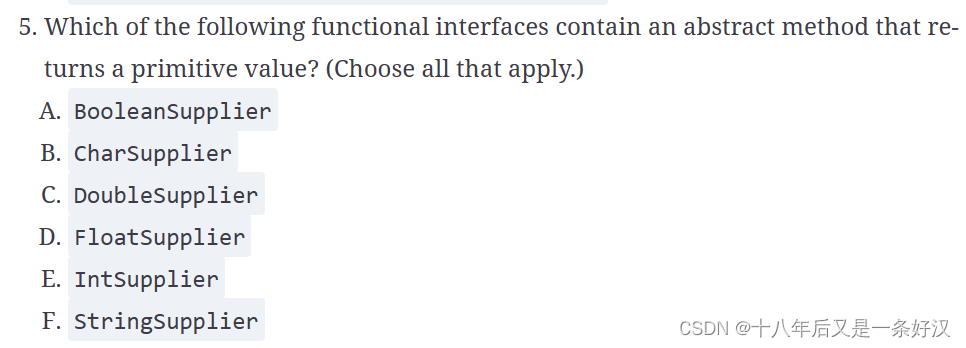
======================== 答案 ========================
======================== 答案 ========================
======================== 答案 ========================
A, C, E.??Java includes support for three primitive streams, along with numerous functional interfaces to go with them:?int,?double, and?long. For this reason, options C and E are correct. Additionally, there is a?BooleanSupplier?functional interface, making option A?correct. Java does not include primitive streams or related functional interfaces for other numeric data types, making options B and D incorrect. Option F is incorrect because?String?is not a primitive but an object. Only primitives have custom suppliers.

======================== 答案 ========================
======================== 答案 ========================
======================== 答案 ========================
A, C.??Predicate<String>?takes a parameter list of one parameter using the specified type. Options E and F are incorrect because they specify the wrong type. Options B and D are incorrect because they use the wrong syntax for the arrow operator. This leaves us with options A and C as the answers.

======================== 答案 ========================
======================== 答案 ========================
======================== 答案 ========================
E.??While there appears to have been a variable name shortage when this code was written, it does compile. Lambda variables and method names are allowed to be the same. The?x?lambda parameter is scoped to within each lambda, so it is allowed to be reused. The type is inferred by the method it calls. The first lambda maps?x?to a?String?and the second to a?Boolean. Therefore, option E is correct.
======================== 答案 ========================
======================== 答案 ========================
======================== 答案 ========================

======================== 答案 ========================
======================== 答案 ========================
======================== 答案 ========================
E.??The question starts with a?UnaryOperator<Integer>, which takes one parameter and returns a value of the same type. Therefore, option E is correct, as?UnaryOperator?extends?Function. Notice that other options don't even compile because they have the wrong number of generic types for the functional interface provided. You should know that a?BiFunction<T,U,R>?takes three generic arguments, a?BinaryOperator<T>?takes one generic argument, and a?Function<T,R>?takes two generic arguments.

======================== 答案 ========================
======================== 答案 ========================
======================== 答案 ========================
A, F.??Option A is correct and option B is incorrect because a?Supplier?returns a value while a?Consumer?takes one and acts on it. Option C is tricky.?IntSupplier?does return an?int. However, the option asks about?IntegerSupplier, which doesn't exist. Option D is incorrect because a?Predicate?returns a?boolean. It does have a method named?test(), making option F correct. Finally, option E is incorrect because?Function?has an?apply()?method.

======================== 答案 ========================
======================== 答案 ========================
======================== 答案 ========================
A, B, C.??Since the scope of?start?and?c?is within the lambda, the variables can be declared or updated after it without issue, making options A, B, and C correct. Option D is incorrect because setting?end?prevents it from being effectively final.
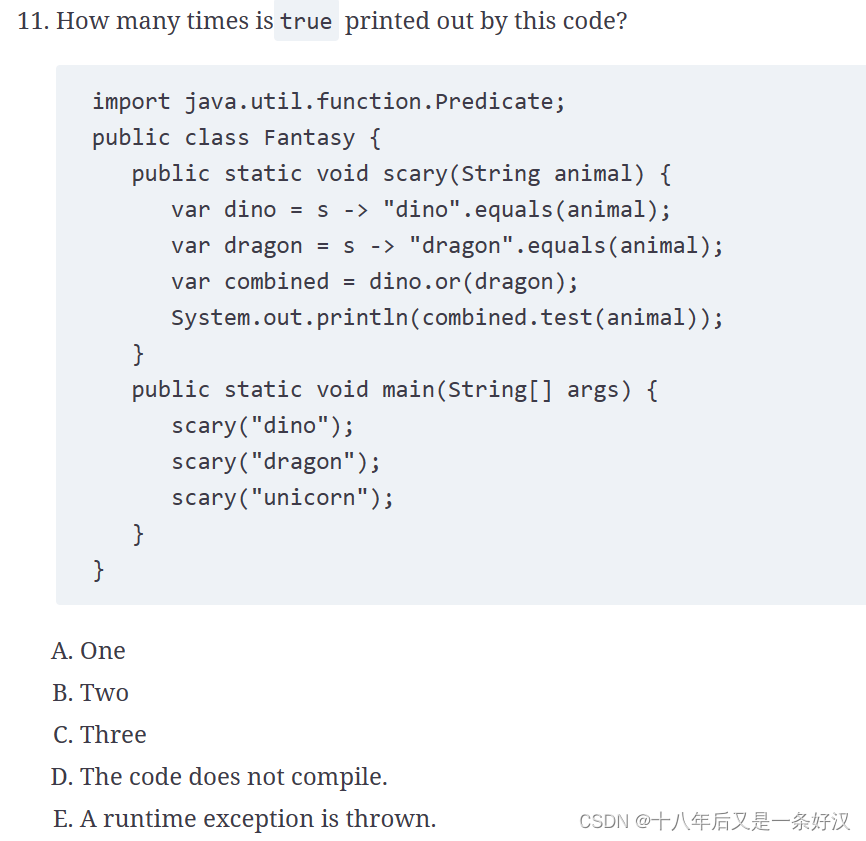
======================== 答案 ========================
======================== 答案 ========================
======================== 答案 ========================
D.??The code does not compile because the lambdas are assigned to?var. The compiler does not have enough information to determine they are of type?Predicate<String>. Therefore, option D is correct.
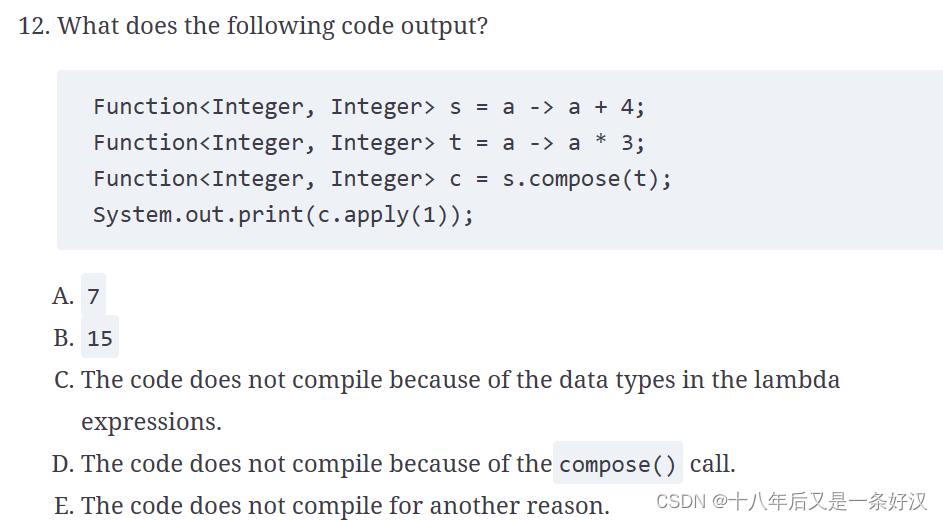
======================== 答案 ========================
======================== 答案 ========================
======================== 答案 ========================
A.??The?a.compose(b)?method calls the?Function?parameter?b?before the reference?Function?variable?a. In this case, that means that we multiply by?3?before adding?4. This gives a result of?7, making option A correct.

======================== 答案 ========================
======================== 答案 ========================
======================== 答案 ========================
E.??Lambdas are only allowed to reference?final?or effectively final variables. You can tell the variable?j?is effectively final because adding a?final?keyword before it wouldn't introduce a compiler error. Each time the?else?statement is executed, the variable is redeclared and goes out of scope. Therefore, it is not reassigned. Similarly,?length?is effectively final. There are no compiler errors, and option E is correct.

======================== 答案 ========================
======================== 答案 ========================
======================== 答案 ========================
B, D.??Option B is a valid functional interface, one that could be assigned to a?Consumer<Camel>?reference. Notice that the?final?modifier is permitted on variables in the parameter list. Option D is correct, as the exception is being returned as an object and not thrown. This would be compatible with a?BiFunction?that included?RuntimeException?as its return type.
Options A and G are incorrect because they mix format types for the parameters. Option C is invalid because the variable?b?is used twice. Option E is incorrect, as a?return?statement is permitted only inside braces ({}). Option F is incorrect because the variable declaration requires a semicolon (;) after it.


======================== 答案 ========================
======================== 答案 ========================
======================== 答案 ========================
A, F.??Option A is a valid lambda expression. While?main()?is a?static?method, it can access?age?since it is using a reference to an instance of?Hyena, which is effectively final in this method. Since?var?is not a reserved word, it may be used for variable names. Option F is also correct, with the lambda variable being a reference to a?Hyena?object. The variable is processed using deferred execution in the?testLaugh()?method.
Options B and E are incorrect; since the local variable?age?is not effectively final, this would lead to a compilation error. Option C would also cause a compilation error, since the expression uses the variable name?p, which is already declared within the method. Finally, option D is incorrect, as this is not even a lambda expression.

======================== 答案 ========================
======================== 答案 ========================
======================== 答案 ========================
C.??Lambdas are not allowed to redeclare local variables, making options A and B incorrect. Option D is incorrect because setting?end?prevents it from being effectively final. Lambdas are only allowed to reference?final?or effectively final variables. Option C compiles since?chars?is not used.

======================== 答案 ========================
======================== 答案 ========================
======================== 答案 ========================
C.??Line 8 uses braces around the body. This means the?return?keyword and semicolon are required. Since the code doesn't compile, option C is the answer
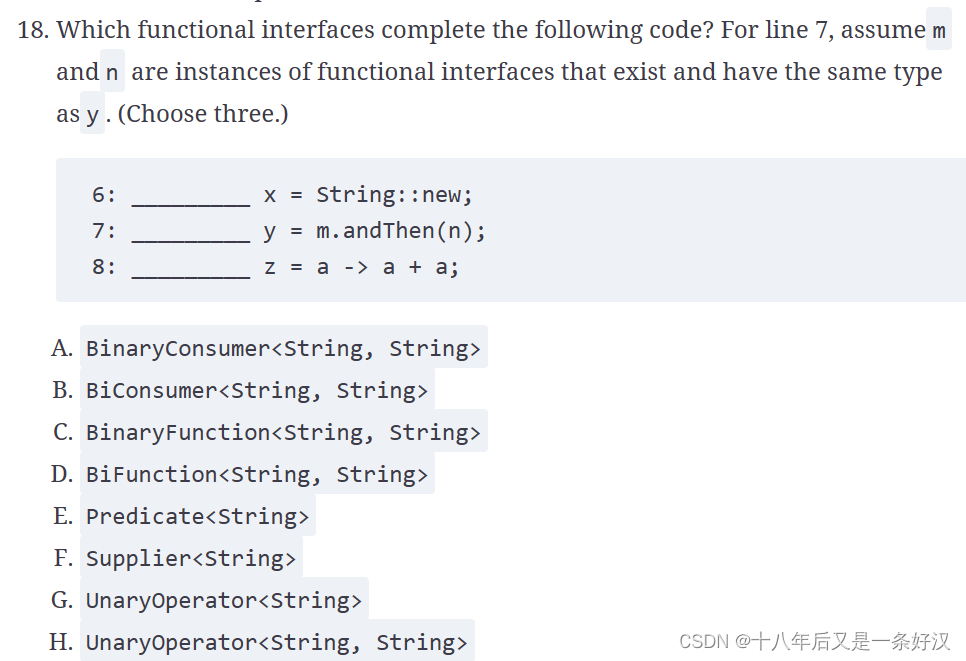
======================== 答案 ========================
======================== 答案 ========================
======================== 答案 ========================
B, F, G.??We can eliminate four choices right away. Options A and C are there to mislead you; these interfaces don't exist. Option D is incorrect because a?BiFunction<T,U,R>?takes three generic arguments, not two. Option E is incorrect because none of the examples returns a?boolean.
The declaration on line 6 doesn't take any parameters, and it returns a?String, so a?Supplier<String>?can fill in the blank, making option F correct. The declaration on line 7 requires you to recognize that?Consumer?and?Function, along with their binary equivalents, have an?andThen()?method. This makes option B correct. Finally, line 8 takes a single parameter, and it returns the same type, which is a?UnaryOperator. Since the types are the same, only one generic parameter is needed, making option G correct.

======================== 答案 ========================
======================== 答案 ========================
======================== 答案 ========================
F.??While there is a lot in this question trying to confuse you, note that there are no options about the code not compiling. This allows you to focus on the lambdas and method references. Option A is incorrect because a?Consumer?requires one parameter. Options B and C are close. The syntax for a lambda is correct. However,?s?is already defined as a local variable, and therefore the lambda can't redefine it. Options D and E use incorrect syntax for a method reference. Option F is correct.


======================== 答案 ========================
======================== 答案 ========================
======================== 答案 ========================
E.??Option A does not compile because the second statement within the block is missing a semicolon (;) at the end. Option B is an invalid lambda expression because?t?is defined twice: in the parameter list and within the lambda expression. Options C and D are both missing a?return?statement and semicolon. Options E and F are both valid lambda expressions, although only option E matches the behavior of the?Sloth?class. In particular, option F only prints?Sleep:, not?Sleep: 10.0.
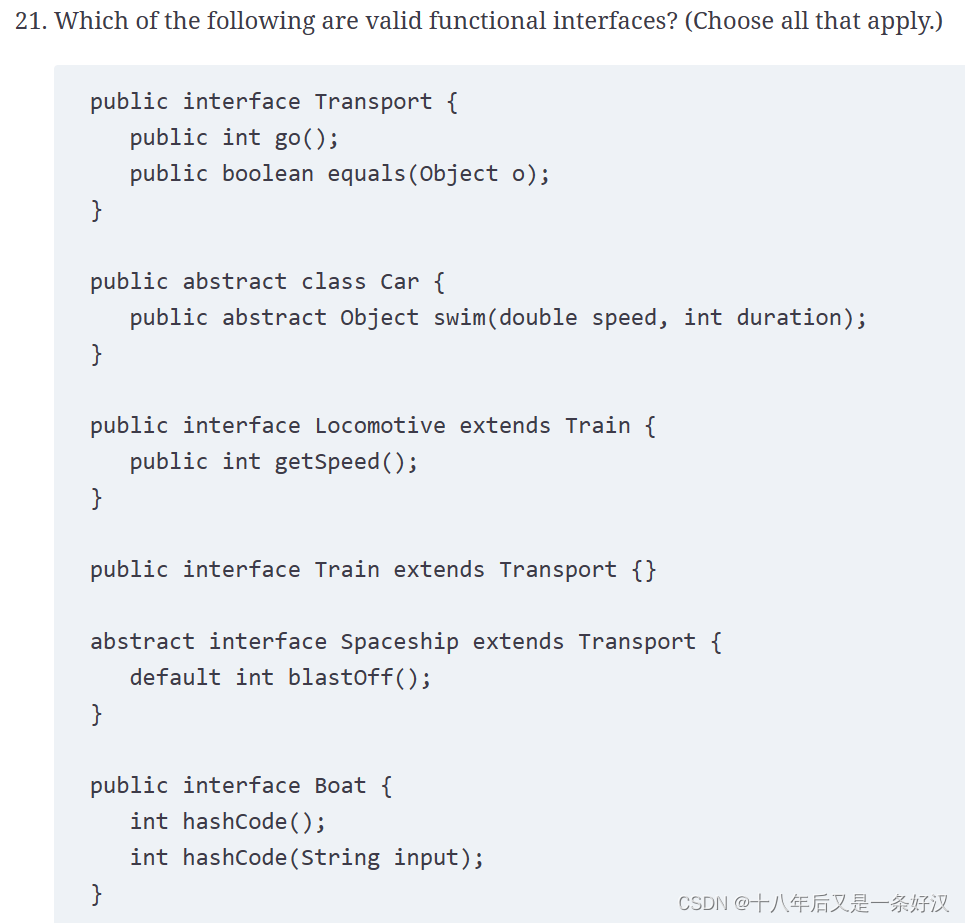
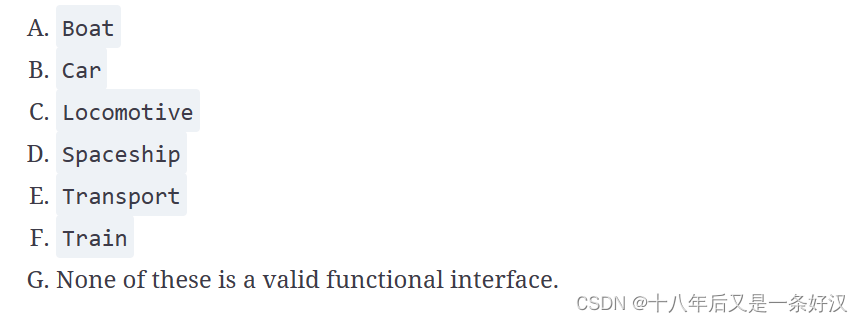
======================== 答案 ========================
======================== 答案 ========================
======================== 答案 ========================
A, E, F.??A valid functional interface is one that contains a single abstract method, excluding any?public?methods that are already defined in the?java.lang.Object?class.?Transport?and?Boat?are valid functional interfaces, as they each contain a single abstract method:?go()?and?hashCode(String), respectively. This gives us options A and E. Since the other methods are part of?Object, they do not count as abstract methods.?Train?is also a functional interface since it extends?Transport?and does not define any additional abstract methods. This adds option F as the final correct answer.
Car?is not a functional interface because it is an abstract class.?Locomotive?is not a functional interface because it includes two abstract methods, one of which is inherited. Finally,?Spaceship?is not a valid interface, let alone a functional interface, because a?default?method must provide a body. A quick way to test whether an interface is a functional interface is to apply the?@FunctionalInterface?annotation and check if the code still compiles.
本文来自互联网用户投稿,该文观点仅代表作者本人,不代表本站立场。本站仅提供信息存储空间服务,不拥有所有权,不承担相关法律责任。 如若内容造成侵权/违法违规/事实不符,请联系我的编程经验分享网邮箱:veading@qq.com进行投诉反馈,一经查实,立即删除!